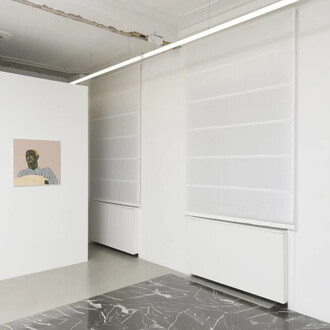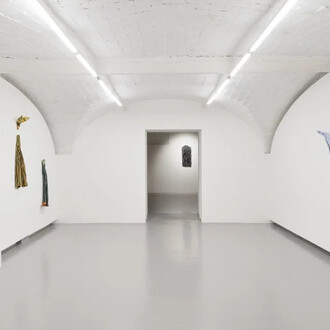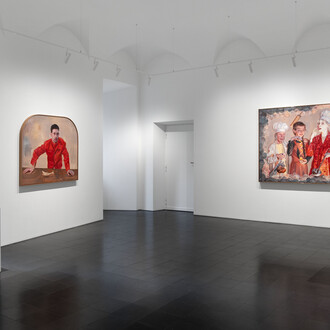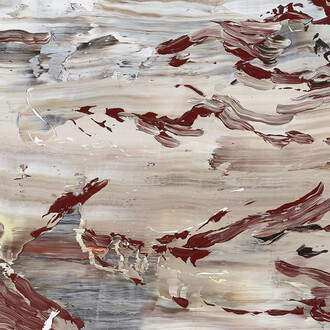They look like small, mysterious, living beings. They breathe faintly, as if they were tired, but of tiredness that has not known fatigue. And then useless bubbles, each different, explode, depicting compositions on the floor. Water, here and there, but to us, words still disturb the breath of beings. Small, mysterious and living beings.
Issued like flags, but without a state. Yet, our words would like to know them. To penetrate their moist cavities. Stealing the secret, the breath.
Aida, for a phenomenology of the encounter
To describe a practice means, first of all, circumscribing a field of intervention. If we were to outline a field of action for Marco Giordano's work, we would have to turn to a concept that the Japanese philosophical tradition expressed using the term Aida: a distance that connects. Aida is the void, the interval, the space of contact between organism and environment. It is said that the best way to represent this notion is to think of an imaginary room that occupies an indefinite position between heaven and earth. Aida, as Bin Kimura wrote, is the “very reality of the event”, it is the original background from which every relationship emerges. We are faced with an event that takes place in a field where no dualism is yet at work, where the territories of the self and those of the other are given as a radical interweaving.
Giordano establishes his practice in this opaque area, he forgets himself and blurs into the relationship: the Aida is his true medium, the ‘between’ is the field of action in which he carries out his practice. It is a realm of in-progress grammar, never codified, always in-situation, which defines the artist's work based on an exogamic principle: affected by a congenital need to be rooted outside of themselves, his works are modeled by a performative logic. Hybrid entities, with a heterogeneous character, they preserve the contradictions and disagreements of the opaque zone that saw their birth. It is for these reasons that grasping them through a careful analysis of their physical properties, however right and precise it may be, is not the correct way to approach them: they are not ‘assertions’ of materials and forms, but object-events that are given in the phenomenological space of the encounter.
Intermezzo
Yes, for sure, between heaven and earth, but how do we get into that room you were telling me about? There must be a means to get there. They have always said that we are a means, that we words are a means, but now that we need a means, how will we manage now?
First of all, the atmosphere
If there is one concept that art critics of the twentieth century have ferociously devoured and proudly respected, it is that of medium. This word now seems to have fared poorly enough, having become one of the many umbrella terms that adorn the infinite sadness of press releases, it enjoys rather precarious health. Yet, notwithstanding the point, that reflection on the term ‘medium’ seems to have reached a point of no return, by investigating its genealogy it is possible to bring out an unforeseen factor that may be productive for the reflections that follow.
Giordano's artistic practice seems to invite us to radically rethink the concept of the medium - beyond the prescriptivism of Greenberg's teleology and post-modern eclecticism - bringing us back to its original meaning, which, as the wide corpus of literature has argued, sees it linked to the Aristotelian term, metaxu. For Aristotle, in order for visual perception to be possible, it is “necessary for there to be a medium [metaxu]”, an intermediate element in which the sensitive takes place: “if someone places the colored object on the eye, he will not be able to see anything” . It is this same metaxu, as Emanuele Coccia wrote, taking 1 up the Aristotelian passage, “that provides us with all of our experi- ences. It is this very medium that relentlessly exudes light and color, sounds and odors [...] In the womb of this medium, corporeal objects become images and can act immediately upon our organs of perception” . Starting from these reflections, it seems particularly appropriate to apprehend the artist's work by using the notion of atmosphere, as formulated in the studies into atmospherics begun by Gernot Böhme and Herman Schmitz. Similar to the “Aristotelian medium”, the atmosphere represents, more precisely, a particular configuration of this medium, a state of excitement. “Atmospheres”, wrote Böhme, “are something between subject and object. They are not something relational but, rather, the relationship itself” . Described as “almost thing”, an “active impression”, the atmosphere is “the qualitative-sentimental, spatially effused prius of our sensitive encounter with the world” . It is the perception of a mood whose specific character cannot be reduced to the sum of its elements.
In My Mouth in your Mind Giordano sculpts this perceptive region embracing the exhibition apparatus and understanding the art object as a bearer of affordance - in the Gibsonian sense - that is, of sensory-motor invitations that regulate the spectator’s experience, taking up an attitude already evident in previous exhibitions, such as ‘Pathetic Fallacy’ - installed in Milan in 2017 for the project space, Il Colorificio - and ‘Cutis’, at the Glasgow Project Room (2017). If the meaning of the exhibition is not consigned to the limits of the object, but to the atmospheric excitement structured by the latter, it now remains to investigate the intonation: the primary atmospheric quality.
Final act
She sings in a shell, she sings like a shell. Her voice is(and) that of the(in the) shell. Like Josephine, the Kafkaesque singer of the mice, who could understand the sound of that voice? Now I understand why you told us that you only wanted things you couldn't comprehend.
In the tongue
Everything, ultimately, in eroticism, leads to crime
(Alberto Moravia)
Bringing erotic and mystical experiences closer together and reflecting on their cognitive scope, Alberto Moravia introduces George Bataille's Storia dell'Occhio: “Eroticism seems to be a form of knowledge, which at the very moment it discovers reality, destroys it. In other words, the real can be known through eroticism, but at the price of the complete and irreparable destruction of the real itself” . Moravia seems to signal to us incommensurability between the erotic experience and the cognitive one, expressing, at the same time, the conviction that both give themselves in a relationship of absolute dependence. “After all”, continues the italian writer, “the form of knowledge proper to eroticism concerns only eroticism. It strives to know itself and through this effort, it manifests itself and expresses itself” .
In the wake of this opening offered to us by Moravia, rather than a precise erotic object, we can rather identify a movement, which defines the erotic as a fulfilling cognitive drive. In My Mouth in your Mind this impulse is not manifested in the obvious analogy between the sculptural volumes and the phallic or vaginal forms, but in a tension that punctually denies the correspondence between these: marked by a lack of anthropomorphism, the installation modules in the exhibition impede the mode of thought that tends to tame the Other, so as to read him under a reassuring anthropic lens. And after all, this same eroticism, this same movement, which leads the artist to work on the most human medium, language, to establish a face-to-face with the sphere of the non-human. In the end, it seems to be an impossible challenge, wedged in the fatal error of object-oriented philosophies, one of “not having questioned the central role that language occupies in the constitution of our ontological representation of the world” . However, it is precisely in this obsessive attempt to bend, to slash the word, that Giordano carries on immersion in that world-without-us, to debilitate the space of logocentrism—the home of symbol and meaning. Moved by an ‘anti-oedipal’ logic, the energy that runs through the exhibition deconsecrates the altar of the word and redesigns the place of the voice, to deliver the results to a music that conveys to us an inextricable interweaving with the Other.
“Humanity and nonhumanity have always performed an intricate dance with each other” , wrote Jane 8 Bennett. My Mouth in your Mind is then an invitation to follow this dance, to abolish the distance that separates us from everything to the murder of the Other: it is in this becoming a world that the sense of eroticism, of crime, is revealed.
Vincenzo Di Rosa
















